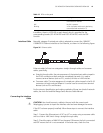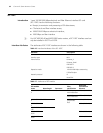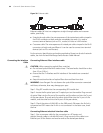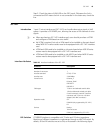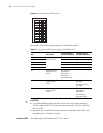
SIC-4FSW/SIC-4FSW-PoE/DSIC-9FSW/DSIC-9FSW-PoE 39
The status description of the LEDs of SIC-1FXS/SIC-1FXO and SIC-2FXS/SIC-2FXO is
shown in the following table:
Interface Cable Connection cables for SIC-1FXS/SIC-1FXO and SIC-2FXS/SIC-2FXO are telephone
cables with ferrite core. Both ends of the cables are RJ11 connectors. For cable
pinouts, see Low-End and Mid-Range Series Routers Cable Manual.
c
CAUTION: The standard shipment package of SIC-1FXS/SIC-1FXO and
SIC-2FXS/SIC-2FXO includes a ferrite core telephone cable.
Connecting the Interface
Cable
c
CAUTION:
■ You should connect a cable to the port with the correct mark. Misplugging is
prone to impair the SIC/MIM and even damage the router.
■ When the telephone cable is used outdoors, it is recommended that users
install a special lightning arrester on the input end of the cable in order to
avoid the lightning effects more efficiently.
■ One end of the telephone cable has a ferrite core. To ensure the compatibility
of the Router, users should connect the end with the ferrite core to the Router.
If the SIC is properly installed, follow these steps to connect the cable:
Step 1: Connect the end with the ferrite core to a RJ11 port of SIC-FXS/SIC-FXO;
Step 2: Insert the other end to
■ a telephone or fax or the AT0 loop trunk if a SIC-1FXS/SIC-2FXS is installed;
■ a subscriber line of exchange if a SIC-1FXO/SIC-2FXO is installed;
SIC-4FSW/SIC-4FSW-Po
E/DSIC-9FSW/DSIC-9FS
W-PoE
Introduction SIC-4FSW/SIC-4FSW-PoE and DSIC-9FSW/DSIC-9FSW-PoE interface cards are
4/9-port 10/100 Mbps Ethernet Layer 2 SIC interface cards that can be used on
H3C MSR 20/30/50 series routers. They provide up to 4/9 10/100 Base-Tx Ethernet
ports for Layer 2 and Layer 3 switching. A router installed with
SIC-4FSW/DSIC-9FSW modules can work as a switching/routing integrated device
on a small-sized enterprise network to connect PCs and network devices inside the
Table 13 Description of the LEDs on SIC-1FXS/SIC-1FXO and SIC-2FXS/SIC-2FXO panels
LED Description
LINK OFF means the link is idle. ON means the
link is being occupied for call connection.
ACT OFF means the link is idle. ON means the
link is being occupied for communication.













